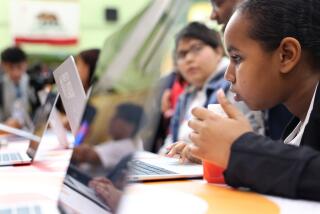Computers Bring School Home
- Share via
COSTA MESA — For the moment, technology has the upper hand.
Middle school teacher Sean Butler clicks a mouse and the computer screen changes. But the transmission lines are overloaded so the program keeps freezing, which means Stacie Aarsvold, a student working on her own computer 15 miles away, gets to play hooky for a few minutes.
Such is education in the 21st century.
Twice a month, at least four of Butler’s students at the private Kline School stay home for the day. But they don’t miss classes. Using computers, video cameras and a conferencing program, they telecommute from as far away as Laguna Beach.
In the process, they learn about innovation and problem-solving, self-reliance and personal responsibility. That they’re also doing algebra in cyberspace is almost beside the point.
“It’s great to be in this,” said Anson Oppegard, 13, as pictures of his classroom flicker on a computer screen in his Costa Mesa home. “I’m learning something every time. You get to figure out what you’re doing wrong, and what you’re doing right.”
Schools have been using the Internet for several years, but usually as an adjunct to traditional education. One of the more popular programs is the Global Schoolhouse, in which a class in one part of the country will hook up with a class somewhere else, and students will swap information about each other. Or the classroom will hook up with an expert, such as scientists from the Jet Propulsion Laboratory in Pasadena.
The programs work relatively simply. School computers run teleconferencing software to hook up with “reflector sites,” larger computers often run by colleges that create a common area through which participants can talk, see or write to each other, like a massive chat room.
But Kline School teachers are using the technology at the logical next level, fully integrating computers with the classroom. All but three of the school’s 75 students in kindergarten through eighth grade have computers at home, said school founder and director Susan Kline. And all grades use e-mail and Internet Web sites for homework assignments.
“Our big thing is the computer is a tool,” Butler said. “We don’t have computer classes--the computer is involved in every class.”
Parents support the concept.
“Just working with the technology is really good for him,” said Marie Fair, Anson’s mother, as Butler spoke through her son’s computer about the end of the Cold War. “It has a lot of potential for him for the future.”
The idea of having students telecommute surfaced last year when Stacie’s family joined her father for an extended overseas business trip that stretched from Paris to the Philippines. Yet Stacie stayed in regular touch with her class, using a portable computer and telephone lines.
Under Butler’s direction last fall, 10- to 13-year-old students began building their own school computers from components, and started learning the software to create a virtual classroom. So far, only four students have the equipment to telecommute, but the experience is shared by all.
On a recent telecommute day, Robert “Buddy” Merrill, 11, sat at the classroom computer and walked Stacie--at home in Laguna Beach--through the correct answers for the day’s math homework assignment.
“It’s a lot better than my old school,” said Buddy, who entered Kline School in the fall after several years in Huntington Beach public schools. He has a computer at house--”I usually type up homework on it,” he said--but doesn’t have the camera or software to telecommute himself. “I’d like to,” he said.
There are snags. Human errors pop up occasionally, such as the recent day when Butler scanned a map of South America into the computer for a history lesson, but photocopied a map of North America to hand out to the classroom.
And the technology, Butler said, has not kept up with the software, so traffic jams on the Web sites routinely crash the computer program. The meeting areas are accessible by anyone with the videoconferencing software, so the class has a constant flow of curious visitors, sometimes overloading the lines.
And while some days it takes just minutes to get the virtual classroom running, other days the programs never do run right.
“That’s what’s great about it, especially for the kids at home, because they have to check the video, check the audio--it’s problem-solving,” Butler said.
Not everyone finds the problem-solving so enthralling.
“At first it was extremely frustrating--it would crash all the time,” Anson said. “We couldn’t talk to each other. It turned out I have the poison microphone. Every time I try to use it I bump everybody off.
“Sometimes you feel like picking up the monitor and chucking it across the room.”
More to Read
Sign up for Essential California
The most important California stories and recommendations in your inbox every morning.
You may occasionally receive promotional content from the Los Angeles Times.














